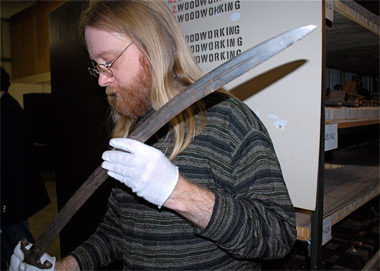
University Museum Archives -- Dan M. Wiley, assistant professor of English and a specialist in the languages and literatures of medieval Britain and Ireland, admires a sword that is part of the museum’s permanent collection. The archives house more than 70,000 artifacts. A study gallery in the University Museum is available for SIU Carbondale teachers and professors to make available to their students art or artifacts as supplementary materials to their syllabi. (Photo by Andrea Hahn)
February 10, 2012
Museum collection offers unique teaching tools
CARBONDALE, Ill. -- Faculty at Southern Illinois University Carbondale have a 3D teaching tool available, with thousands of component parts from which to choose.
It’s not new technology; in fact most of it isn’t new at all.
It’s the archived collection belonging to the University Museum.
The University Museum has, at any given time, several exhibits running, some of them traveling exhibits on loan from other museums, some of them based on annual themes, some of them selected to highlight particular sections of the collection. One of the exhibit spaces is the study gallery, a space set aside specifically for teachers to display art or artifacts relevant to classroom instruction.
The museum archives, housed in the McLafferty Annex, include more than 70,000 items. Many of the items are themselves part of collections donated as a cohesive group; some are individual pieces. Besides art, there are collections of geologic specimens, ethnic and international art and artifacts, and a large historical collection,
Lorilee C. Huffman, curator of exhibits, knows the archives well, having worked with the collection for 30 years. She, and University Museum Director Dona Bachman hope more teachers will make use of the archives as a teaching tool more often and in more ways.
“We would really like professors and teachers to think about objects that might be appropriate to incorporate into their coursework,” Bachman said.
That, of course, requires some knowledge of specifically what is in the archives.
Kimberly Leonard, dean of the College of Liberal Arts, recently organized a field trip for professors in the college to tour the archives. Racks of paintings and photographs; closets of historical clothing and fabric artifacts; shelves of artifacts, from Melanesian masks and Japanese lacquer work to folk art carvings and replicas of fossils, and a whole roomful of historical and fine furniture -- the breadth of the collection, its uniqueness, and the very rareness of some of the items made the tour an adventure.
Dan M. Wiley, assistant professor of English and a specialist in the languages and literature of the medieval British Isles, was part of the archives tour. He counted it a positive experience, and found several items, including a sword, particularly to attract his attention.
"No one discipline can give us a complete picture of the past,” he said. “That's why many scholars, myself included, prefer an interdisciplinary approach that involves language, literature, history, and archaeology. Artifacts in particular are great teaching tools because they provide a tangible connection to a time and a place we will never know firsthand."
Besides touring the facility, there are other ways for teachers and professors to find material objects to complement their syllabi. A grant from the Institute of Museum and Library Services has improved the manual records, and will see digitization of others, particularly in the ethnographic, archaeological and historic collections.
Susannah Munson, curator of the anthropology collection, is in the process of overseeing the digitization phase of the project, which includes photographing, providing a description of and categorizing nearly 4,000 items into 26 online collection portfolios.
Until the digitization is complete, or to learn about items not included in this project, professors can gather information about the archives or find things to include in the study gallery the old fashioned way -- they can consult the experts.
“The archives are the repository of institutional memory,” Huffman said, meaning not only that the archives include items of particular importance in SIU Carbondale history, but also that the archives reflect the expertise of SIU Carbondale faculty.
For example, the archives include an extensive collection of Oceanic artifacts. Some of the collection came from a donation by Morton May, a department store magnate who also donated part of his collection to the St. Louis Art Museum. Some of the University Museum collection, including photo documentation, came by way of Philip J. C. Dark, SIU Carbondale professor emeritus of anthropology and a leading expert in the people of Papua, New Guinea. The Oceanic collection then, besides being of value as an historical and artistic collection, also preserves an era in the academic history of the University.
More recently, the University Museum received 50 pieces of the Vogel Collection from the National Gallery of Art in Washington, D.C., the only museum in Illinois to do so. The donation reflects the importance of the museum as a cultural and historical storehouse for the Southern Illinois region as a whole and the University in particular.
